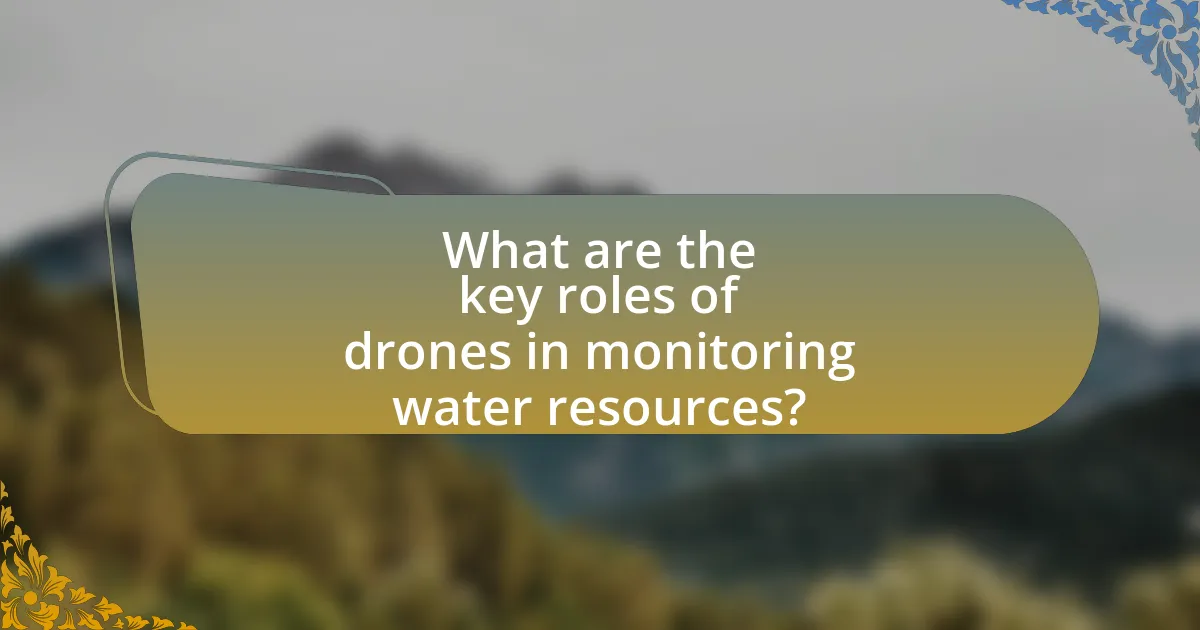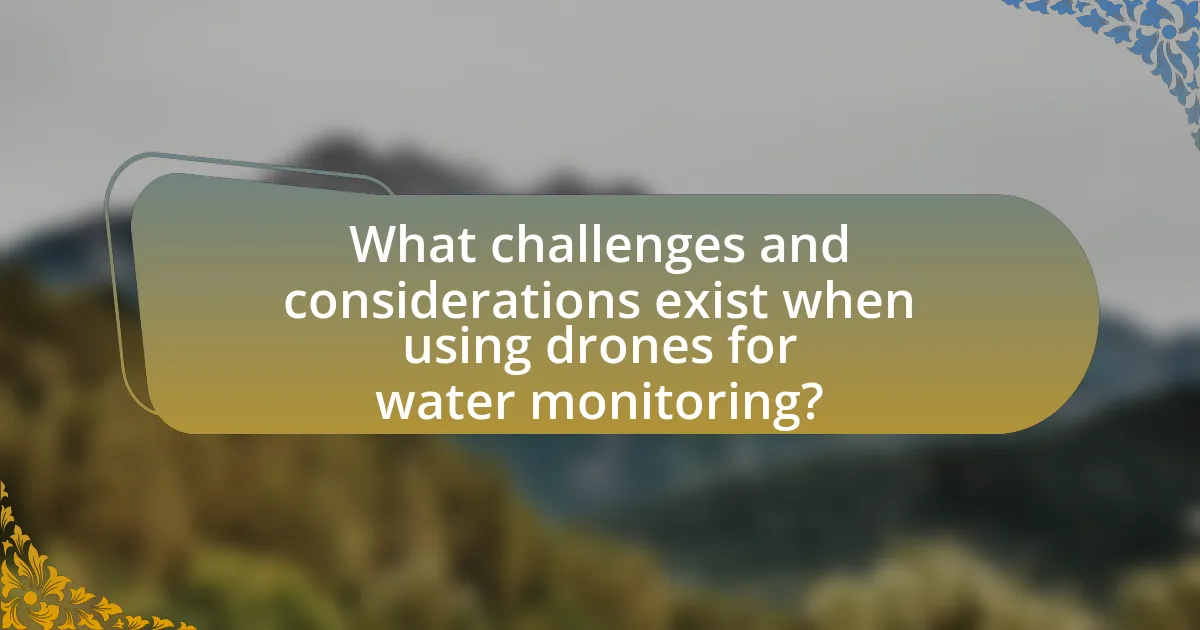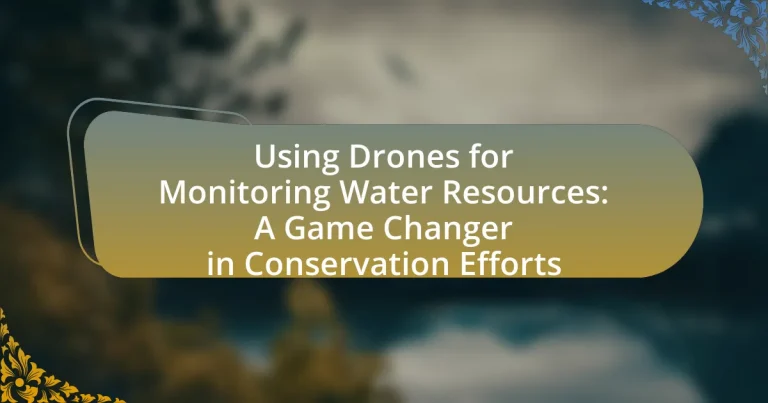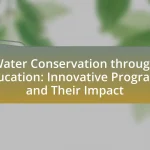Drones are revolutionizing the monitoring of water resources by providing high-resolution aerial imagery, real-time data collection, and efficient mapping capabilities. This technology enables the assessment of water quality, detection of pollution sources, and monitoring of changes in water levels and vegetation. Drones equipped with specialized sensors can gather critical data on various water parameters, enhancing the accuracy of water resource management and conservation efforts. The article explores the specific applications of drones in water quality assessment, irrigation management, and pollution identification, while also addressing the challenges and regulatory considerations associated with their use in environmental monitoring.

What are the key roles of drones in monitoring water resources?
Drones play a crucial role in monitoring water resources by providing high-resolution aerial imagery, enabling real-time data collection, and facilitating efficient mapping of water bodies. These unmanned aerial vehicles can cover large areas quickly, allowing for the assessment of water quality, detection of pollution sources, and monitoring of changes in water levels and vegetation around water bodies. For instance, studies have shown that drones equipped with multispectral sensors can identify algal blooms and assess water clarity, which is vital for maintaining ecosystem health. Additionally, drones can be used to create detailed topographical maps that aid in hydrological modeling and resource management, thereby enhancing conservation efforts.
How do drones enhance data collection for water resource management?
Drones enhance data collection for water resource management by providing high-resolution aerial imagery and real-time data analysis. These unmanned aerial vehicles can cover large areas quickly, capturing detailed information on water quality, quantity, and distribution. For instance, drones equipped with multispectral sensors can assess vegetation health and monitor changes in land use that affect water resources. Research conducted by the University of California, Davis, demonstrated that drone technology can improve the accuracy of water usage assessments by up to 30%, allowing for more effective management strategies. This capability enables water resource managers to make informed decisions based on precise, timely data, ultimately leading to better conservation outcomes.
What types of data can drones collect regarding water resources?
Drones can collect various types of data regarding water resources, including water quality metrics, hydrological data, and spatial imagery. Water quality metrics encompass parameters such as temperature, pH, turbidity, and dissolved oxygen, which can be measured using specialized sensors mounted on drones. Hydrological data includes information on water flow, levels, and surface area, which can be gathered through remote sensing techniques. Spatial imagery provides high-resolution aerial views of water bodies, allowing for the assessment of vegetation cover, land use changes, and potential pollution sources. These data types enable effective monitoring and management of water resources, supporting conservation efforts.
How does drone technology improve the accuracy of water monitoring?
Drone technology enhances the accuracy of water monitoring by providing high-resolution aerial imagery and real-time data collection. Drones equipped with advanced sensors can capture detailed information about water quality parameters such as temperature, turbidity, and chemical composition over large areas quickly and efficiently. For instance, studies have shown that drones can cover up to 100 acres in a single flight, significantly reducing the time and labor required for traditional monitoring methods. Additionally, the integration of GPS and remote sensing technology allows for precise mapping and tracking of water bodies, enabling more accurate assessments of changes in water levels and quality over time.
What advantages do drones offer over traditional monitoring methods?
Drones offer significant advantages over traditional monitoring methods, primarily through enhanced efficiency, cost-effectiveness, and improved data accuracy. Unlike ground-based monitoring, drones can cover large areas quickly, capturing high-resolution images and data in real-time, which allows for timely decision-making in conservation efforts. For instance, a study by the University of California, Davis, demonstrated that drones could reduce the time needed for vegetation mapping by up to 90% compared to traditional methods. Additionally, drones can access hard-to-reach areas, providing data that might otherwise be missed, thus improving the overall quality of environmental assessments.
Why are drones considered more cost-effective for water resource monitoring?
Drones are considered more cost-effective for water resource monitoring because they significantly reduce operational costs compared to traditional methods. Traditional monitoring often involves extensive manpower, equipment, and travel expenses, while drones can cover large areas quickly and efficiently with minimal human intervention. For instance, a study by the University of Southern California found that using drones for water quality assessments can lower costs by up to 70% compared to ground-based monitoring techniques. This efficiency not only saves money but also allows for more frequent data collection, enhancing the overall effectiveness of water resource management.
How do drones increase efficiency in monitoring large water bodies?
Drones increase efficiency in monitoring large water bodies by providing rapid, high-resolution aerial imagery and data collection capabilities. These unmanned aerial vehicles can cover vast areas quickly, allowing for real-time monitoring of water quality, vegetation health, and wildlife populations. For instance, studies have shown that drones can capture data over 100 acres in a single flight, significantly reducing the time and labor required compared to traditional ground surveys. Additionally, drones equipped with sensors can detect changes in water temperature, turbidity, and chemical composition, enabling timely interventions in conservation efforts.

What specific applications do drones have in water resource conservation?
Drones have specific applications in water resource conservation, including monitoring water quality, mapping water bodies, and assessing irrigation efficiency. For instance, drones equipped with multispectral sensors can capture data on water quality parameters such as temperature, turbidity, and chlorophyll levels, enabling timely interventions to prevent pollution. Additionally, drones can create high-resolution maps of lakes, rivers, and wetlands, facilitating better management and conservation strategies. In agriculture, drones help evaluate irrigation systems by identifying areas of over- or under-watering, thus optimizing water usage and promoting sustainable practices. These applications demonstrate the effectiveness of drones in enhancing water resource management and conservation efforts.
How are drones used in assessing water quality?
Drones are utilized in assessing water quality by capturing high-resolution aerial imagery and collecting data on various water parameters. These unmanned aerial vehicles can be equipped with sensors to measure temperature, pH, turbidity, and chlorophyll levels, providing real-time insights into water conditions. For instance, a study published in the journal “Remote Sensing” demonstrated that drones could effectively monitor algal blooms and other pollutants in lakes, showcasing their capability to enhance water quality assessments.
What sensors are commonly used in drones for water quality analysis?
Common sensors used in drones for water quality analysis include multispectral sensors, turbidity sensors, and temperature sensors. Multispectral sensors capture data across various wavelengths, allowing for the assessment of chlorophyll levels and other water quality indicators. Turbidity sensors measure the cloudiness of water, which is crucial for understanding sediment levels and overall water clarity. Temperature sensors provide essential data on thermal conditions, which can affect aquatic life and chemical processes in water bodies. These sensors collectively enable comprehensive monitoring of water quality, supporting conservation efforts and resource management.
How do drones help in identifying pollution sources in water bodies?
Drones assist in identifying pollution sources in water bodies by providing high-resolution aerial imagery and real-time data collection. Equipped with sensors, drones can detect specific pollutants, such as heavy metals or organic compounds, and monitor changes in water quality over time. For instance, studies have shown that drones can effectively map algal blooms and track their movement, which is crucial for pinpointing nutrient runoff sources. Additionally, drones can cover large areas quickly, allowing for efficient monitoring of remote or hard-to-reach locations, thereby enhancing the ability to identify and address pollution sources effectively.
In what ways can drones assist in managing water distribution?
Drones assist in managing water distribution by providing real-time monitoring, data collection, and analysis of water resources. They can survey large areas quickly, capturing high-resolution images and data that help identify water sources, assess water quality, and detect leaks in distribution systems. For instance, a study by the University of California demonstrated that drones equipped with thermal imaging can identify temperature variations in water bodies, indicating potential contamination or evaporation losses. Additionally, drones can facilitate precision irrigation by mapping soil moisture levels, allowing for optimized water usage in agriculture. This capability not only enhances efficiency but also supports sustainable water management practices.
How do drones contribute to irrigation management in agriculture?
Drones significantly enhance irrigation management in agriculture by providing precise data on crop health and soil moisture levels. Equipped with advanced sensors and imaging technology, drones can capture high-resolution aerial imagery, allowing farmers to identify areas requiring irrigation and assess water distribution efficiency. For instance, studies have shown that drone imagery can detect variations in plant health, which correlates with soil moisture content, enabling targeted irrigation practices. This targeted approach not only conserves water but also improves crop yields, as evidenced by research indicating that precision irrigation can reduce water usage by up to 30% while maintaining or increasing agricultural productivity.
What role do drones play in monitoring water levels in reservoirs?
Drones play a crucial role in monitoring water levels in reservoirs by providing real-time data collection and analysis. Equipped with advanced sensors and imaging technology, drones can capture high-resolution images and gather precise measurements of water levels, enabling efficient monitoring over large areas. Studies have shown that drone technology can improve the accuracy of water level assessments by up to 90% compared to traditional methods, allowing for timely decision-making in water resource management. This capability is particularly valuable in regions facing water scarcity or environmental changes, as it facilitates proactive conservation efforts and enhances the overall management of water resources.

What challenges and considerations exist when using drones for water monitoring?
Using drones for water monitoring presents several challenges and considerations, including regulatory restrictions, technical limitations, and data accuracy concerns. Regulatory restrictions often involve airspace regulations and permissions required for drone flights, which can vary significantly by region. Technical limitations include battery life, payload capacity, and the need for specialized sensors to collect relevant water quality data. Data accuracy concerns arise from potential interference, environmental factors affecting sensor readings, and the need for calibration to ensure reliable results. These challenges must be addressed to effectively utilize drones in water monitoring efforts.
What regulatory issues must be addressed for drone usage in water monitoring?
Regulatory issues that must be addressed for drone usage in water monitoring include compliance with aviation regulations, data privacy laws, and environmental protection standards. Compliance with aviation regulations, such as those set by the Federal Aviation Administration (FAA) in the United States, is crucial to ensure safe operation in airspace. Data privacy laws, including the General Data Protection Regulation (GDPR) in Europe, must be considered to protect individuals’ privacy when collecting data over water bodies. Additionally, environmental protection standards, such as the Clean Water Act, require that drone operations do not disturb ecosystems or violate water quality regulations. Addressing these regulatory issues is essential for the responsible and effective use of drones in monitoring water resources.
How do airspace regulations impact drone operations for water resource management?
Airspace regulations significantly impact drone operations for water resource management by dictating where and how drones can be deployed. These regulations often restrict drone flights in certain areas, such as near airports or populated regions, which can limit access to critical water monitoring sites. For instance, the Federal Aviation Administration (FAA) in the United States enforces specific airspace classifications that require drone operators to obtain waivers or permissions for flights in controlled airspace, thereby complicating timely data collection for water resource assessments. Additionally, compliance with regulations regarding altitude limits and flight visibility can affect the efficiency and effectiveness of drone operations, as operators must navigate these constraints while attempting to gather essential data on water quality and availability.
What are the privacy concerns associated with drone surveillance of water bodies?
Drone surveillance of water bodies raises significant privacy concerns primarily due to the potential for unauthorized monitoring of individuals and private property. This surveillance can capture images and data without consent, infringing on personal privacy rights. For instance, drones equipped with high-resolution cameras can inadvertently record private activities occurring near water bodies, leading to potential misuse of the footage. Additionally, the lack of clear regulations governing drone operations can exacerbate these privacy issues, as individuals may not be aware of their rights regarding surveillance in public and private spaces. Studies indicate that public sentiment is increasingly wary of drone surveillance, with many expressing concerns about the erosion of privacy in both urban and rural settings.
How can users ensure effective drone operation for water monitoring?
Users can ensure effective drone operation for water monitoring by conducting thorough pre-flight planning, utilizing appropriate sensors, and adhering to regulatory guidelines. Pre-flight planning involves assessing the monitoring area, determining optimal flight paths, and scheduling flights during favorable weather conditions to enhance data accuracy. Employing sensors such as multispectral or thermal cameras allows for precise data collection on water quality and temperature variations. Additionally, compliance with local aviation regulations ensures safe operation and minimizes risks, as demonstrated by studies indicating that adherence to guidelines significantly reduces operational incidents.
What best practices should be followed for drone maintenance and operation?
Best practices for drone maintenance and operation include regular inspections, firmware updates, and adherence to manufacturer guidelines. Regular inspections ensure that all components, such as propellers, batteries, and cameras, are functioning correctly and free from damage. Firmware updates are crucial for optimizing performance and enhancing safety features, as manufacturers frequently release updates to address issues and improve functionality. Adhering to manufacturer guidelines ensures that operators follow recommended procedures for safe and effective use, which is essential for maintaining the drone’s longevity and reliability. These practices are supported by industry standards, such as those outlined by the Federal Aviation Administration (FAA), which emphasize the importance of maintenance and operational protocols for safe drone usage.
How can users troubleshoot common issues encountered with drones in water monitoring?
Users can troubleshoot common issues encountered with drones in water monitoring by systematically checking the drone’s battery, GPS signal, and camera functionality. Ensuring the battery is fully charged and in good condition prevents power failures during flight. Verifying the GPS signal is strong helps maintain accurate positioning, which is crucial for effective monitoring. Additionally, testing the camera before deployment ensures that it captures clear images and data, which is essential for analysis. These steps are supported by industry best practices that emphasize pre-flight checks to enhance operational reliability and data quality in environmental monitoring.


